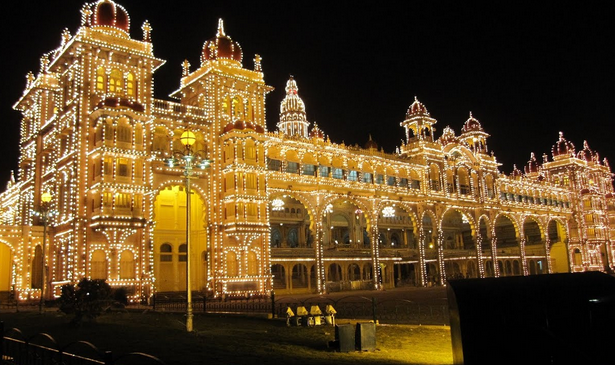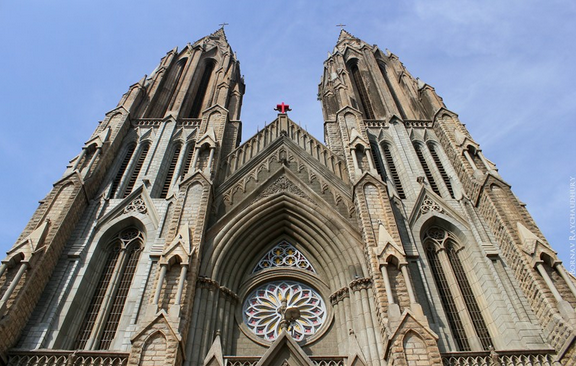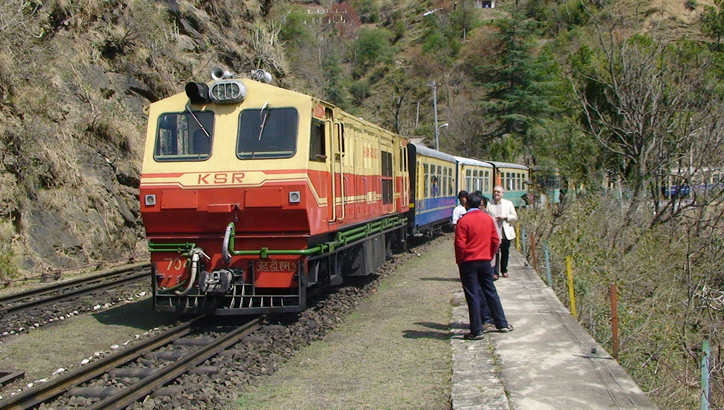
As the official capital of the erstwhile Maharajas, Mysore has flourished in retaining its royal aura. Reflections of the lavish lifestyle can be found almost everywhere, from the railway station to government offices and hospitals. As you enter this fascinating city of gardens and palaces, you are swept off your feet by the powerful scent of sandalwood, the aroma of which fills the air. It is aptly called the ‘Sandalwood City.’
8 Top Tourist Places to Visit in Mysore
Mysore Palace
Undoubtedly the biggest tourist attraction of Mysore is the Mysore Palace. The seat of power of the Maharajas of Mysore, built in the Indo-Saracenic style, the palace is a treasure house and a repository of immense artistic wealth. The exquisite carvings that adorn every room of the palace, the sheer magnitude of wealth that is on display is breathtaking and is bound to leave every visitor spellbound. One of the most priceless objects of the palace is the jewel studded gold throne of the Wodeyar dynasty. On Saturdays, Sundays, public holidays and national festivals the entire palace is illuminated which is a spectacular vision.
Chamundi Hills
Reached by climbing 1000 steps or by travelling 13 kilometers by road, Chamundi Hill is a famous landmark of Mysore. Atop this hill is the temple of Chamundeshwari, the patron goddess of the Wodeyars. There is an enormous statue of Mahisasura, the demon whom Chamundeshwari had vanquished. Halfway along the steps is a gigantic monolithic statue of Nandi, the bull which is considered to be extremely sacred. The hill offers a panoramic aerial view of the city of Mysore.
Brindavan Gardens
Spread over an area of 150 acres, Brindavan Gardens is situated 19 kilometers from Mysore City at the base of the Krishnaraja Sagar Dam built across river Cauvery. The 2.4 kilometers long dam forming a 130 square kilometers lake is one of the biggest in India. The terraced and meticulously planned garden with beautifully illuminated and dancing fountains is a treat for the eyes.
Mysore Zoo
The Mysore Zoo or the Chamarajendra Zoological Gardens is home to some exotic and rare species of fauna and a myriad species of animals. Over the years with much effort, the Zoo has emerged as one of the finest in the country with plans to set up state-of-the-art Rescue and Rehabilitation Centre. It also enjoys the distinction of breeding animals in captivity.

St. Philomena’s Church
Built between 1933 and 1941, the gothic style church is reminiscent of medieval architectural style with lofty towers and stained glass windows. In many ways it resembles the Cologne Cathedral. St. Philomena Church remains open to public between 5.00am and 6.30pm.
Jaganmohan Palace
Also known as Chamarajendra Art Gallery, Jaganmohan Palace has a huge repository of paintings by Ravi Verma and Nicholas Roerich. Some exquisite curios in sandalwood, ivory, stone and ceramics are also displayed here.
Jayalakshmi Vilas
Built by the Wodeyar ruler – Maharaja Chamaraja, Jayalakshmi Nivas is one of the royal mansions he built for his eldest daughter in 1905. An architectural landmark of Mysore, the mansion is now a property of Mysore University and houses the Folklore Museum. Built on an elevated land, it is opposite to the Kukkarahalli Tank.
Srirangapatna
On the way to Mysore, situated 14 kilometers from the city is Srirangapatna, the capital of Mysore State under Tipu Sultan. After his death in 1799 A.D. the British shifted the capital to Mysore. In Srirangapatna is Daria Daulat Palace, Tipu’s summer palace made of teakwood. The walls are covered with beautiful frescoes. There is the Masjid-e-Ala or Juma Masjid built by Tipu with lofty minarets. The Ranganathaswamy temple in Srirangapatna is very famous, containing the idol of Lord Vishnu. The Gumbaz housing the tombs of Tipu Sultan, his father Hyder Ali and mother Fathima Begum is renowned for its craftsmanship.



